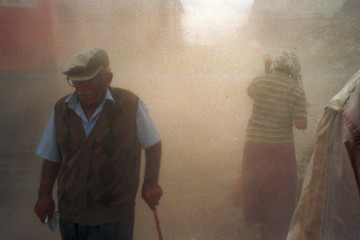

As I drove through Samandag, the sounds of excavators demolishing buildings echoed endlessly. The city had been heavily damaged by the twin earthquakes at the start of the year and the amount of reconstruction work that was needed was massive. The dust created by the demolition was carried by the wind and settled everywhere, leaving the city covered in a thick layer.
In Hatay, one of the areas most affected by the earthquake in southeast Turkey, the dust has become toxic and poses a potentially deadly threat to its inhabitants.
These people are currently living under difficult conditions, either in containers or tents, and many have limited access to basic necessities such as electricity, water, and essential products.
"We are trying to educate people. We don't want children to die of asbestos in five years"
The 7.8-magnitude earthquake on February 6 killed over 45,000 people in Turkey and thousands more in neighbouring Syria and completely devastated hundreds of thousands of buildings.
The United Nations Development Program (UNDP) reported that the earthquakes damaged more than 313,000 structures, with a staggering 210 million tons of rubble needing to be cleared. The President of Turkey, Recep Tayyip Erdogan, pledged to rebuild the affected areas within one year. However, local residents and organisations have criticised the rebuilding process.
The dust and rubble in the air contain hazardous heavy metals. "Household appliances such as fridges and televisions each have chemical products that end up in the atmosphere after being destroyed by the earthquake," explains Ali Kanalti, representative of the Turkish Medical Association in the province of Hatay.
It is also important to note that exposure to asbestos can cause even more harm if a doctor is already treating cases of allergies or infections. Despite its ban in Turkey in 2010, many buildings in the area were constructed before. increasing the risk of exposure. The governorate of Hatay conducted tests for asbestos levels in seven locations in June and claimed that they were below the legal limit.
However, the Turkish Chamber of Environmental Engineers (ÇMO) analysed eight samples from various locations in April and found asbestos in four of them, indicating a potential threat to public safety.
|
Private companies are responsible for demolishing and disposing of the debris. However, as The New Arab observed, regulations aren't always followed. According to ÇMO, workers are required to wear masks, protective clothing, and gloves. To minimise dust, companies are obligated to spray water during demolition, but this is not always done.
Locals taking action
In response to the risks posed by the earthquake, local residents and organisations have taken action. One such individual is Ümit Güç, a filmmaker and co-founder of Kolektif Koordinasyon. This organisation was established immediately following the earthquake to provide urgent assistance such as food delivery, but now primarily focuses on education and has even provided a safe space for up to 700 children.
On the day that The New Arab went to visit Kolektif Koordinasyon in Tomruksuyu, a small village between Samandag and Antakya, Ümit Güç was out at a destruction site with his team. He had heard that water was not being used.
|
|
During the car ride to the demolition site, the atmosphere was tense and the three men put on face masks. Upon arriving, Ümit rushed out to stop the demolition worker's engine.
Dust was flying everywhere, carried by the wind and getting into everyone's eyes. The family who owned the house being destroyed watched helplessly. The worker stopped working and got out of the engine.
He wasn't wearing any protective gear and didn't seem to be aware of the risks or regulations. That day, Ümit had to visit this destruction site twice because the worker resumed work as soon as the group left, as well as another site a few kilometres away.
"We are trying to educate people. We don't want children to die of asbestos in five years," Ümit pleaded.
Dumping next to protected sites
There are concerns about the way rubble is managed following demolitions. Trucks carrying the rubble are often uncovered, and the waste is dumped in open landfills, some of which are located near residential areas. One landfill in Samandag is particularly close to the sea, and when viewed from a distance, it blends in with the nearby mountain. The lack of proper management for this rubble has been criticised.
On the other side of the road, a container city, konteyner kent in Turkish, has been installed for survivors. While not wearing protection, a representative of the landfill showed The New Arab water tubes used to spray the landfill, assuring compliance with regulations.
The decision to locate the landfill has been met with criticism due to its proximity to the sea and Milleyha Bird Sanctuary.
Michel Atik, the founder of the Samandag Environmental Protection Association, has expressed concern over the impact on the millions of migratory birds that use the sanctuary each year. He believes that the landfill and resulting debris pose a threat not only to people but also to the region's biodiversity and agricultural industry.
Hatay is responsible for 20% of Turkey's food production, and contamination of the soil could have far-reaching consequences for the health of both inhabitants and wildlife, as well as the local economy.
In Atik's words, "People, animals, plants, and nature all face a great threat."
Mathilde Warda is French freelance journalist. Her work focuses on the Mediterranean region with particular reference to Tunisia and Turkey
Follow her on Twitter: @MathildeWarda



 Follow the Middle East's top stories in English at The New Arab on Google News
Follow the Middle East's top stories in English at The New Arab on Google News


